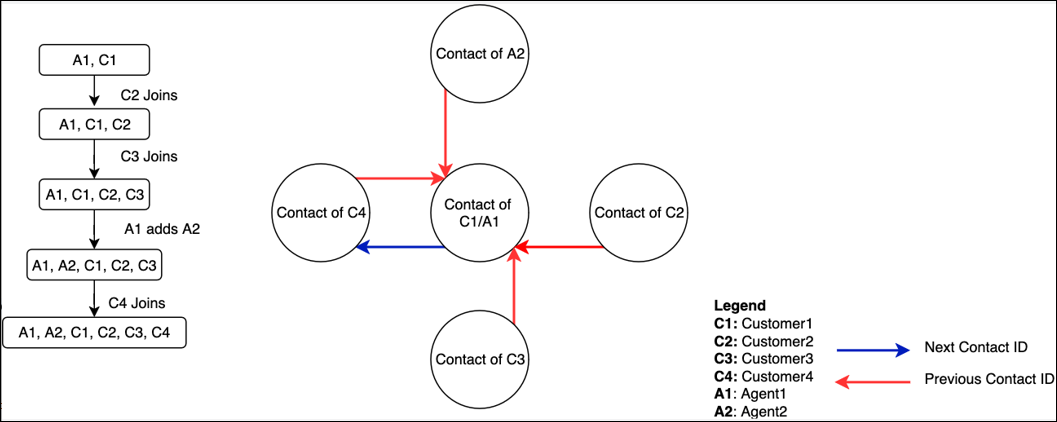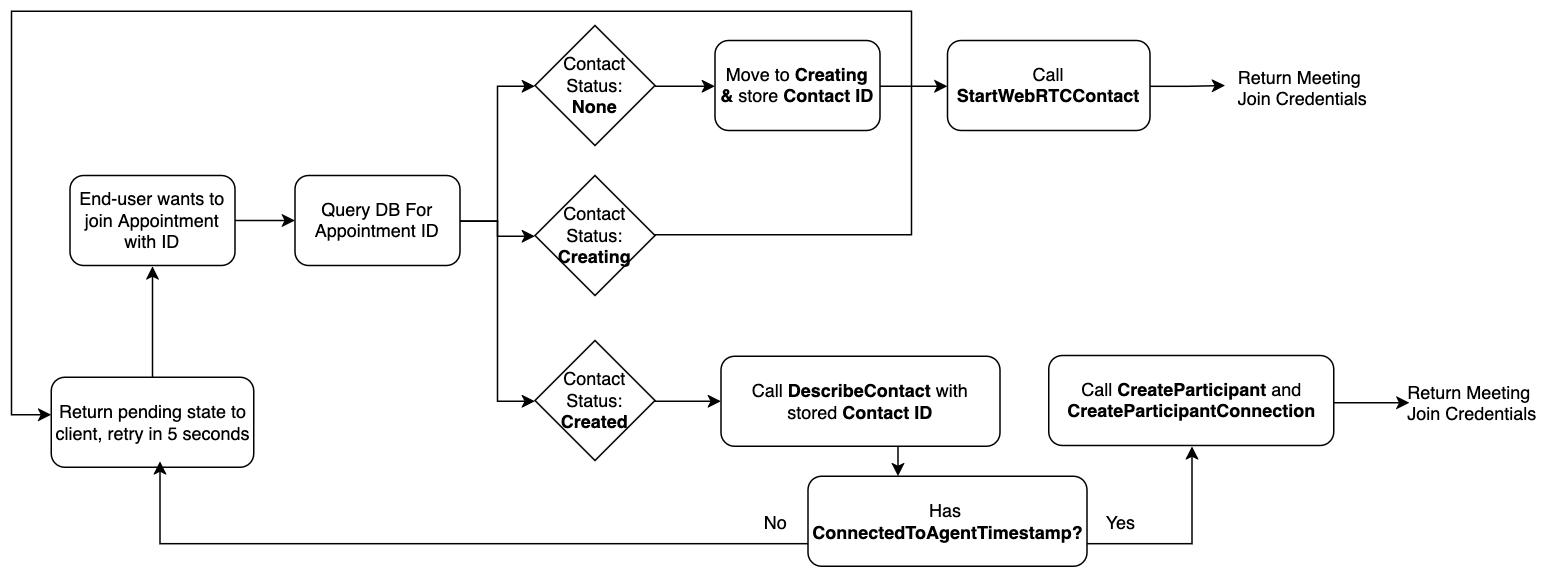Die vorliegende Übersetzung wurde maschinell erstellt. Im Falle eines Konflikts oder eines Widerspruchs zwischen dieser übersetzten Fassung und der englischen Fassung (einschließlich infolge von Verzögerungen bei der Übersetzung) ist die englische Fassung maßgeblich.
Aktivieren Sie In-App-, Web- und Videoanrufe für mehrere Benutzer
Amazon Connect unterstützt das Hinzufügen zusätzlicher Benutzer zur Teilnahme am In-App-, Web- und Videoanruf in einem bestehenden Anruf. Sie können bis zu vier zusätzliche Benutzer zu einem laufenden oder geplanten In-App-, Web- oder Videoanruf hinzufügen, sodass insgesamt sechs Teilnehmer vorhanden sind: der Agent, der erste Benutzer und vier weitere Teilnehmer (Benutzer oder Agenten).
Wie füge ich Teilnehmer zu einem Mehrbenutzeranruf hinzu
-
Um Anrufe mit mehreren Benutzern zu aktivieren, müssen Sie die erweiterte Kontaktüberwachung für mehrere Teilnehmer von der Amazon Connect Konsole aus aktivieren.
-
Sobald dieser Vorgang abgeschlossen ist, können Sie mithilfe der vorhandenen Amazon Connect StartWebRTCContactAPI einen Kontakt erstellen und diesen Kontakt an einen Agenten weiterleiten.
-
Um einen weiteren Teilnehmer hinzuzufügen, erstellen Sie zunächst einen Teilnehmer,
ContactIdder die StartWebRTCContactAPI-Antwort an die CreateParticipantAPI weiterleitet. CreateParticipantwird erst erfolgreich sein, wenn der ursprüngliche Anrufer eine Verbindung zum Agenten hergestellt hat. Die Video- und Screenshare-Funktionen für den Teilnehmer können vor Ort eingestellt werden.ParticipantDetails.ParticipantCapabilities -
Nach erfolgreichem CreateParticipantAbschluss wird ein Teilnehmer-Token zurückgegeben. Dieses Token kann in einer Anfrage CreateParticipantConnectionmit der
TypeEinstellung auf verwendet werdenWEBRTC_CONNECTION. Die Antwort beinhaltet ConnectionData, welche für die Teilnahme an der Besprechung mithilfe der Amazon Chime SDK-Clientbibliotheken für den zusätzlichen Teilnehmer verwendet werden können, die erstellt wurden. Folgen Sie den Integrationsanweisungen, damit der Endbenutzer Ihrer Anwendung an dem Meeting teilnehmen kann.Anmerkung
CreateParticipantgibt den Fehler Bad Request zurück, wenn der Agent noch nicht mit dem Kontakt verbunden ist. Informationen zu Geschäftsanwendungen, bei denen Benutzer versuchen können, Mitglied zu werden, bevor der Agent verbunden ist, finden Sie unterUmgang mit gleichzeitigen Benutzerbeiträgen.
-
Die zusätzlichen Kunden können nach CreateParticipantConnectionRücksendungen jederzeit eine Verbindung herstellen. Nach dem Beitritt der Teilnehmer ähnelt das gesamte zusätzliche Sprach- und Aufnahmeverhalten dem der Mehrparteienfunktion. Die neuen Teilnehmer können ihr Video und ihre Bildschirmübertragung aktivieren, sofern ihre Funktionen in der CreateParticipantAnfrage aktiviert wurden.
Anmerkung
Insgesamt können nur 6 Teilnehmer (Kunden und Agenten) jederzeit an einem aktiven Anruf teilnehmen. Die Amazon Chime SDK-Clientbibliotheken geben einen Statuscode zurück, der angibt, dass der Anruf ausgelastet ist, wenn während des Beitritts zur Besprechung eine Aktion ergriffen wird, um zusätzliche Teilnehmer hinzuzufügen, die das Limit überschreiten.
-
Nachdem die Teilnehmer mit dem Anruf verbunden sind und dann für eine vorkonfigurierte Zeit ordnungsgemäß oder nicht ordnungsgemäß getrennt werden, sind ihre Teilnehmeranmeldedaten nicht mehr gültig. Wenn der Client Library
onAudioVideoDidStopObserver einen Statuscode erhält, der angibt, dass der Teilnehmer nicht mehr gültig ist, können Anwendungen einen neuen Anruf an CreateParticipantund CreateParticipantConnectionvon Ihrem Geschäfts-Backend auslösen, um wieder an dem Anruf teilzunehmen. -
Amazon Connect Erstellt für jede weitere Benutzerverbindung einen neuen Kontakt und einen neuen Kontaktdatensatz. Alle zusätzlichen Kontakte haben den InitialContactId (d. h. den, der von der StartWebRTCContactAPI erstellt wurde) PreviousContactId eingestellt, um ihn auf den ursprünglichen Kontakt zurückzuverfolgen. Jeder Kontaktdatensatz:
-
Hat eine "InitiationMethod„: „WEBRTC_API“
-
Hat die folgenden Segmentattribute:
"SegmentAttributes": { "connect:Subtype": { "ValueString": "connect:WebRTC" } },
Darüber hinaus hat jeder Kontaktdatensatz den Anzeigenamen, der unter angegeben ist
CreateParticipant. Die Agenteninformationen werden nicht für zusätzliche Benutzerkontakte ausgefüllt. Dies dient dazu, die Vervielfältigung von Agenteninformationen zu vermeiden.Das folgende Diagramm zeigt, wie der vorherige und der nächste Kontakt in einem Szenario zugeordnet IDs werden, in dem mehrere Teilnehmer und Agenten zu einem Web-, In-App- oder Videoanruf hinzugefügt werden.

-
Umgang mit gleichzeitigen Benutzerbeiträgen
Unternehmen möchten möglicherweise Anwendungen erstellen, denen Benutzer in beliebiger Reihenfolge und zu jeder Zeit beitreten können. Beispielsweise kann Ihre Anwendung per E-Mail einen Link mit einer externen Termin-ID an mehrere Benutzer senden, über den sie zu einem festgelegten Zeitpunkt an einem Anruf teilnehmen können. Um dieses Verhalten zu erreichen, müssen Geschäfts-Backends sicherstellen, dass:
-
Der erste Benutzer, der beitritt, löst eine StartWeb RTCContact Anfrage aus.
-
Alle weiteren Benutzer verwenden CreateParticipant und, CreateParticipantConnection aber erst, nachdem der erste Benutzer eine Verbindung zu einem Agenten hergestellt hat.
In diesem Abschnitt wird eine mögliche Implementierung beschrieben, vorausgesetzt, Ihr Geschäfts-Backend enthält einen Speicher (wie DynamoDB), der Metadaten zu geplanten Terminen speichern kann. Beachten Sie, dass geplante Termine kein Feature von Amazon Connect, sondern ein Teil der Beispielimplementierung sind.
Wenn der Benutzer zu der Seite navigiert, sollte er eine Anfrage an das Backend senden. Das Backend prüft:
-
Ob der Benutzer den Termin beginnen kann und ob es der richtige Zeitpunkt ist.
-
Ob der Amazon Connect Kontakt bereits durch einen Anruf erstellt wurde StartWebRTCContact.
Wenn der Kontakt noch nicht erstellt wurde, sollte der Kunde die StartWebRTCContactAPI mit einem benutzerdefinierten Ablauf und einem Attribut aufrufen, das die Agentenwarteschleife des entsprechenden Agenten angibt, von dem erwartet wurde, dass er dem Anruf beitreten würde. Der Flow sollte einen Block „Arbeitswarteschlange einrichten“ enthalten, der so konfiguriert ist, dass er die in den Attributen angegebene Agentenwarteschlange verwendet. Der Flow sollte dann mit einem Block „In die Warteschlange übertragen“ enden. Bevor die API aufgerufen wird, sollte das Backend den Speicher atomar aktualisieren, um den Aufruf vom Status „Keine“ in den Status „Creating“ zu versetzen und alle Ausnahmen bei gleichzeitigen Änderungen zu behandeln.
Die Anmeldeinformationen von StartWebRTCContactsollten an den Kunden zurückgegeben werden und dieser sollte sofort am Anruf teilnehmen. Der Kontakt sollte zusammen mit der Kontakt-ID im Business Store als „Erstellt“ gekennzeichnet sein. Diese Business-API muss zwischen allen möglichen Teilnehmern, die beitreten, synchronisiert werden. Dies kann mithilfe der atomaren Operationen geschehen, die von einer Datenbank bereitgestellt werden.
Wenn sich der Kontakt im Status Creating befindet, sollte der zusätzliche Benutzer diesen Status erhalten, die entsprechenden Informationen anzeigen und es nach einer kurzen Wartezeit erneut versuchen.
Wenn der Kontakt erstellt wurde: Sie sollten die Kontakt-ID abrufen und die DescribeContactAPI aufrufen. Das Business-Backend sollte nach dem Contact.AgentInfo.ConnectedToAgentTimestampFeld suchen. Wenn es nicht existiert, hat der erste Benutzer keine Verbindung zum Agenten hergestellt, und der weitere Benutzer sollte die entsprechenden Informationen anzeigen und es nach einer kurzen Wartezeit erneut versuchen.
Wenn das Feld existiert, sollte das Backend aufrufen und dann CreateParticipantCreateParticipantConnection, wie in den vorherigen Abschnitten beschrieben ConnectionData, abrufen.
Der Backend-Flow sollte wie folgt aussehen.

Informationen zur Implementierung finden Sie in den In-App-Anrufbeispielen von Amazon Connect
Der Agent nimmt nicht über dieselbe Website teil. Der Agent sollte seinen Status im Contact Control Panel auf Verfügbar setzen. Wenn der erste Kunde beitritt, wird der Agent automatisch angerufen.
Fakturierung
Die Abrechnung für zusätzliche Teilnehmer entspricht der bestehenden Abrechnung für den ersten Kunden und alle am Anruf beteiligten Agenten. Für Audio, Video und Screen-Sharing fallen jeweils eigene, teilnehmerspezifische Gebühren an.
Verhalten halten
Während eines Videoanrufs oder einer Screensharing-Sitzung können Agenten das Video oder die Bildschirmübertragung des Teilnehmers sehen, auch wenn der Teilnehmer in der Warteschleife ist. Es liegt in der Verantwortung des Teilnehmers, die personenbezogenen Daten entsprechend zu behandeln. Wenn Sie die native CCP-Anwendung verwenden, ist das Agenten-Video deaktiviert, wenn ein Teilnehmer, der kein Agent ist, in der Warteschleife ist. Wenn Sie dieses Verhalten ändern möchten, können Sie ein benutzerdefiniertes CCP- und Kommunikations-Widget erstellen.
Weitere Informationen finden Sie unter Integrieren Sie In-App-, Web-, Videoanrufe und Screensharing nativ in Ihre Anwendung.
Einschränkung
Bei der Erstellung zusätzlicher Teilnehmer in der App, im Internet, bei Videoanrufen und bei der Bildschirmübertragung gilt die folgende Einschränkung:
-
Für die zusätzlichen Teilnehmer dürfen die Videofunktionen nicht auf Senden gesetzt sein, wenn der ursprüngliche Kontakt erstellt wurde und die Videofunktionen des Kunden auf „Keine“ gesetzt waren.